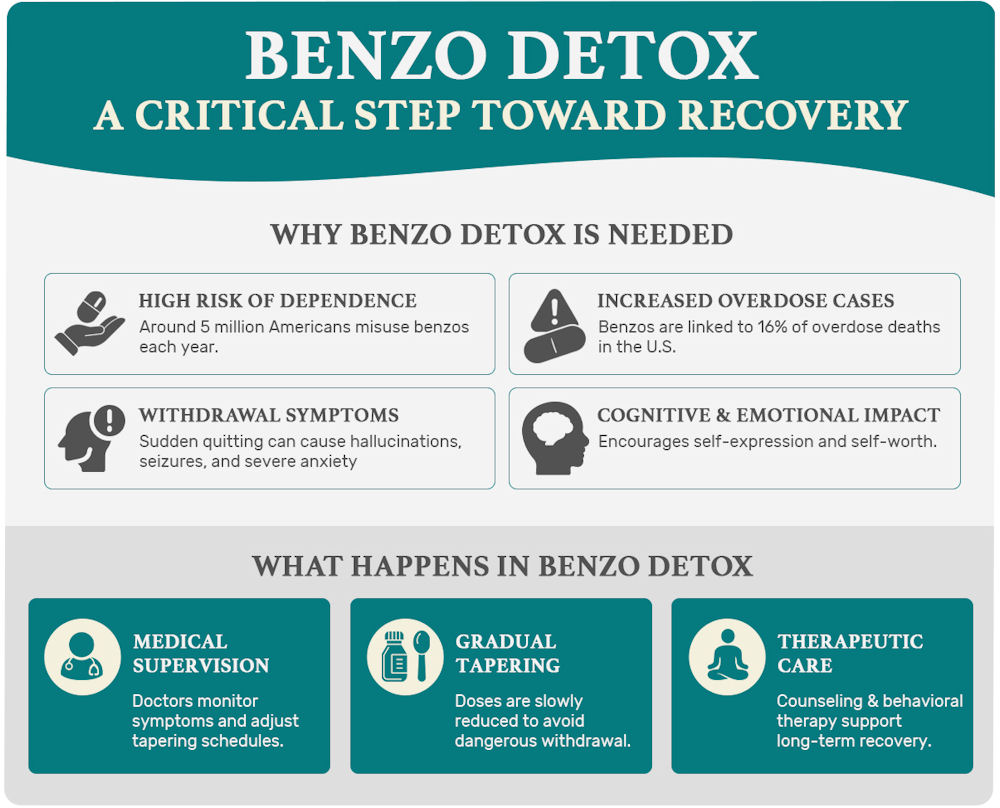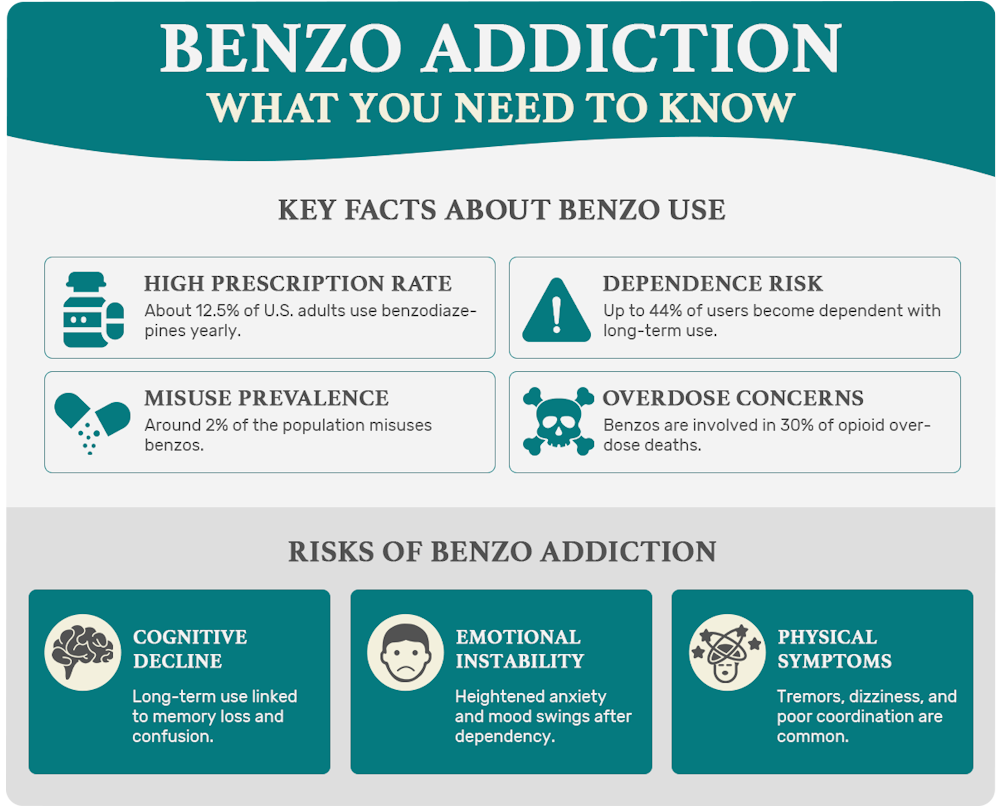Benzo Addiction Treatment in California
- #23 Alprazolam
- #38 Clonzapam
- #55 Lorazepam
- #91 Diazepam
Comprehensive Care for Benzodiazepine Dependence and Withdrawal
Our residential rehab in Orange County, CA, provides a safe, structured, and clinically supervised environment where clients can begin recovery with expert medical support and compassionate care.
A Brief History on Benzodiazepines
The benzodiazepines drug class then became highly successful, because the sedative effects of the drugs acted effectively on anxiety, depression mixed with anxiety, and other conditions, while being deemed relatively safe at the time.5 Although as time passed, addictiveness did enter the picture.
In 1963, Roche introduced the benzodiazepine that became then the most successful drug in pharmaceutical history by the end of the 1960s: Valium, also known by its generic name, diazepam. By 1971, Librium and Valium brought in $200 million in sales for Roche, a hefty part of the total of $280 million in sales in the United States for Roche that year.5 By 1977, it was estimated that approximately 8,000 tons of benzodiazepines were being consumed each year in the United States.
What Are Benzodiazepines?
Over time, benzodiazepine use can lead to tolerance, where higher doses are needed to achieve the same effect. This dose escalation increases the risk of benzodiazepine misuse, overdose, and cognitive decline. The National Institute on Drug Abuse and the American Psychiatric Association both warn that benzodiazepines are addictive, and discontinuing them without medical supervision can cause severe and even life-threatening withdrawal symptoms.
At Laguna Shores Recovery, we understand that benzodiazepine dependence is a medical condition, not a moral failing. Our addiction medicine specialists offer evidence-based, compassionate care to help clients safely detox, manage withdrawal, and rebuild their lives.
Benzodiazepines are used to treat anxiety-related conditions, such as Generalized Anxiety Disorder (GAD) because of the calming effects the drug has on the brain’s neurons.
Benzodiazepines are powerful anticonvulsants that makes them highly effective for epileptic seizure prevention.
To avoid dependence, short-term use of benzodiazepines to treat insomnia may be effective in helping people get restful sleep. It’s especially effective when the person also has an anxiety disorder, because benzodiazepines can be used to treat both conditions simultaneously.
Most commonly, the benzodiazepine drugs used to induce anesthesia include diazepam, flunitrazepam and midazolam, which help decrease stress before surgery.
As a result of the interactions that benzodiazepines have on the nervous system, people with muscle spasms can find relief via benzodiazepines.
The two most common benzodiazepines used in the treatment of alcohol withdrawal are chlordiazepoxide and diazepam. These drugs help individuals recovering from alcohol dependence by eliminating toxins from their bodies and decreasing risks of severe alcohol withdrawal reactions, which is why alcohol rehab for women Orange County programs often incorporate medical supervision to ensure a safe and effective recovery.
How Benzodiazepines Affect the Brain
Commonly prescribed benzodiazepines include:
- Alprazolam (Xanax)
- Lorazepam (Ativan)
- Diazepam (Valium)
- Clonazepam (Klonopin)
- Temazepam (Restoril)
Because of their impact on the CNS, stopping these medications abruptly can trigger benzodiazepine withdrawal syndrome, with symptoms such as anxiety, insomnia, tremors, sweating, muscle spasms, and, in severe cases, seizures.
Alprazolam is widely used in the treatment of anxiety and panic disorders. It has been in use since 1981.
Lorazepam is widely used to treat insomnia and anxiety. It can also be used in sedation as well as treating vomiting and nausea. It has been in use since 1977.
Diazepam is widely used as a muscle relaxant and to combat anxiety. When diazepam is administered intravenously, it can help alleviate severe agitation. It is also used as preparation for anesthesia, as well as a sedative for invasive procedures or minor surgeries. Diazepam is also used to treat epileptic seizures. It has been in use since 1963.
Clonazepam is mainly used as an anticonvulsant drug for treating epilepsy. It has been in use since 1997.
Temazepam is taken orally to treat insomnia. It has been in use since 1981.
Triazolam is an oral benzodiazepine used mostly in the treatment of insomnia. It has been in use since 1982.
Clorazepate is used as an anticonvulsant to manage epileptic seizures, as well as a drug for the treatment of anxiety and alcohol withdrawal. It has been in use since 1972.
Midazolam is administered intravenously as an anesthetic for conscious sedation or as a supplement in general anesthesia. It was approved for use in 1985.
Estazolam is taken orally to treat insomnia. It has been in use since 1990.
Chlordiazepoxide is taken orally to treat anxiety and alcohol withdrawal symptoms. It has been in use since 1960.
Flurazepam is that is used as a sleeping aid in the treatment of insomnia.
Be Brave. Get Help.
Benzo Withdrawal and Detox at Laguna Shores Recovery
Our withdrawal management protocols include:
- Benzodiazepine tapering with gradual dose reduction
- Low-dose flumazenil or gabapentin to ease symptoms
- Subcutaneous infusion for controlled medication delivery
- Support for co-occurring alcohol withdrawal
- Antidepressants and melatonin to stabilize mood and sleep
- 24/7 medical monitoring by licensed healthcare providers
Individuals with high-dose benzodiazepine dependence or benzodiazepine mono dependence management needs receive personalized tapering schedules developed by our clinical team. This individualized approach reduces the intensity of withdrawal syndrome and prevents relapse.

Dual Diagnosis Treatment for Benzo Addiction
We use a blend of pharmacological interventions and psychological treatment methods, including:
- Cognitive Behavioural Therapy (CBT) – Helps individuals identify negative thought patterns and develop healthier coping mechanisms.
- Dialectical Behavior Therapy (DBT) – Effective for emotional regulation and managing borderline personality traits.
- Motivational Interviewing – Encourages internal motivation for recovery.
- Support groups and family therapy – Strengthen connection and accountability throughout treatment.
Treating both the addiction and the underlying mental health issues reduces relapse risk and promotes lasting recovery.
Long-Term Effects of Benzodiazepine Use
- Cognitive decline
- Dependence and withdrawal
- Increased risk of falls and accidents
- Adverse effects on memory and mood
- Negative effects when combined with other substances
Individuals who continue to use higher doses or combine benzodiazepines with alcohol or other drugs face greater health risks, including benzodiazepine overdose and respiratory depression. The Diagnostic and Statistical Manual of Mental Disorders (DSM-5) classifies benzodiazepine use disorder as a serious condition requiring professional addiction treatment.
Benzodiazepine withdrawal can cause you to feel dizzy and off balance. This is a common symptom that should go away in a few weeks.
Vertigo, a disordered state of mind, can be a side effect, especially when taken with other classes of drugs, such as antidepressants.
Losing consciousness can be caused by benzodiazepines as well as other medications. Fainting may be a sign of a more serious, life-threatening condition.
Numbness in the extremities or the face can be a side effect of long-term use.
Cognitive impairment that is benzodiazepine induced can include amnesia, drowsiness, sedation, motor impairment, inattentiveness and lack of voluntary coordination of muscle movements.
A change in mental status to confusion results in an inability to think clearly, loss of ability to recognize people or places and feeling disoriented.
Since benzodiazepines have a sedative effect, it can also slow down reaction times. It’s important to understand the effects of these drugs before you operate heavy machinery or a motor vehicle.
Due to the neurological effects that benzodiazepines have on the brain, impaired judgement can result.
One side effect is a decrease in sex drive.
If you are experiencing one or more of these side effects, see your doctor. Benzodiazepines should never be stopped abruptly, but should be tapered off under the supervision of a healthcare professional.
If you try to detox on your own, you could experience serious withdrawal symptoms, seizures and possibly death.
Evidence-Based Therapies for Benzo Addiction
Therapies at Laguna Shores Recovery include:
- Cognitive Behavioural Therapy (CBT) for relapse prevention and anxiety management
- Trauma-informed care and EMDR for clients with PTSD or trauma-related drug use
- Medication-Assisted Treatment (MAT) to manage physical symptoms and cravings
- Group therapy and peer support groups to build community
- Life skills training and relapse prevention education
These comprehensive therapies help clients manage mental health, rebuild confidence, and develop coping skills for sustained sobriety.

Reach out to verify your insurance coverage for addiction treatment
Alcohol Withdrawal and Benzodiazepine Cross-Dependence
At Laguna Shores Recovery, our medical team provides integrated detox and rehabilitation for clients with both alcohol and benzodiazepine use disorders, ensuring safe detoxification and effective long-term treatment.
If you experience nausea, it should go away within the first two weeks after your last dose.
Abdominal pain is a common withdrawal reaction and should subside within the first week or two.
Any nausea should lessen within the first week or two after your last dose.
Uncontrollable shakiness can occur when the prescription is stopped, because of the tolerance that was built up from taking the medication for the long-term.
Excessive sweating during the daytime and night sweats while you are trying to sleep can happen during withdrawal. As your body adjusts to having no drugs in its system, it may react by sweating until the adjustment is completed.
It rarely occurs, but some people experience hallucinations during withdrawal.
Withdrawal can cause dizziness and feelings of instability, but these symptoms are common and should diminish in a few weeks.
It’s common to feel very tired and have a lack of motivation as withdrawal reactions are happening while you wean off benzodiazepines. Energy levels gradually return over time, but initially it may be hard to get started or accomplish anything.
Confusion as a withdrawal reaction may be the result of poor cognitive functioning. Confusion usually improves gradually over the first several weeks.
Benzodiazepines act on the brain’s receptors to reduce anxiety. Without the drug, the GABA neurotransmitter activities are significantly affected, which can cause anxiety as a withdrawal reaction.
Feeling sad and depressed are common withdrawal reactions as the body and brain adjust to the reduction.
If you are taking benzodiazepines specifically to control seizures, you can experience an increased risk of developing seizures when you discontinue the drug. This risk increases if you withdraw too quickly. However, individuals without previous seizures have an increased risk of seizures if they taper down too quickly from the drug.
Thinking about suicide, also called suicidal ideation, can be the result of depression that many go through during withdrawal. If you feel sad, depressed and hopeless, suicidal thoughts may follow. If you have thoughts of suicide, tell someone on the detox staff. Thoughts of suicide are related to the withdrawal and should improve with time.
Begin Benzo Addiction Treatment at Laguna Shores Recovery
Our multidisciplinary team, comprising experts in addiction medicine, general internal medicine, and mental health care, offers the most effective treatment for benzodiazepine abuse and dual diagnosis conditions. We tailor every treatment plan to your unique needs, helping you restore balance, confidence, and lasting wellness.
Take the First Step Toward Recovery
Verify Your Insurance Online or Call Us Today to learn more about our benzodiazepine addiction treatment programs in Orange County, California.
https://www.drugabuse.gov/drugs-abuse/opioids/benzodiazepines-opioids
https://livertox.nih.gov/BenzodiazepineDrugs.htm
https://www.mdpi.com/2226-4787/6/2/43
https://www.drugabuse.gov/related-topics/trends-statistics/overdose-death-rates
https://www.drugabuse.gov/publications/research-reports/misuse-prescription-drugs/what-scope-prescription-drug-misuse
https://www.ncbi.nlm.nih.gov/pubmed/12891648

 Matthew Beck B.A, M.A, LMFT
Matthew Beck B.A, M.A, LMFT 


